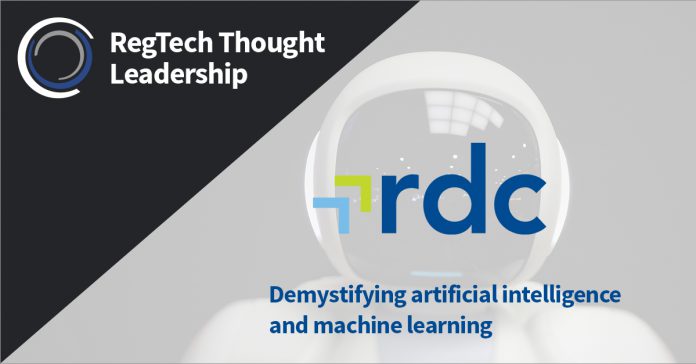Artificial intelligence and machine learning are changing the regulatory landscape and fueling the rise of RegTech. However, their dependence on data is often overlooked, according to a new white paper by RDC.
The financial services industry is facing an unprecedented level of regulation. To ease the burden, many organisations are turning to RegTech as an answer to their problems. More than $2.5bn was invested in the sector in the first six months of the year, which is equal to 87.2% of the total capital raised by RegTech companies in 2015, 2016 and 2017 combined, according to research by RegTech Analyst. The rise in investment demonstrates a burgeoning interest in how innovation in technology is changing the landscape.
The researched showed that KYC and AML are causing the biggest headaches, with the two regulations dominating the RegTech investment landscape.
AI is applied to stress testing for financial forecast models or automating the tracking and monitoring of regulatory changes, while machine learning can be used for enterprise email filtering as an example.
Michael Kerman, chief marketing officer at RDC, told RegTech Analyst: “Compliance and regulatory changes are creating the need for more accurate, higher performance ways to screen potential customers.
“Historically, the answer was to simply hire armies of compliance analysts. This has proven to be very expensive and doesn’t get to the root of the problem. As a result, banks and financial institutions are looking for new ways to improve their KYC/AML compliance.”
RDC’s new white paper examined the tight interdependence of data and ML in the context of anti-money laundering and regulatory compliance. The paper suggests that with financial institutions needing to know a great deal about the money they’re taking in and paying out, firms are rushing to see whether they can apply AL and ML to relieve the pressure on their analysts and drive efficiency – while still maintaining a high level of protection.
However, what is often overlooked is the degree to which they depend on good data in order to be effective.
“The limitations really aren’t technical, they’re more about application of the technology,” Kerman added. “AI and Machine Learning are sophisticated algorithms that are developed and then refined by processing tremendous amounts of data and having known outcomes. Many companies are experimenting with AI/ML, but lack the data required to adequately train the model.”
RDC offers world-class risk and compliance protection, allowing global organisations to identify banned/suspected entities, strengthen fraud protection, ensure regulatory compliance, manage supply and distribution risk, and protect their brand equity.
The company claims it is able to achieve this by utilising the world’s largest open source risk-relevant database, which provides AML/KYC compliance; Politically Exposed Persons (PEP) protection; emerging market intelligence; corruption, fraud and crime protection; and vendor screening and monitoring.
Despite the limitations of the tech and need for ‘good data’, Kerman still sees AI/ML as playing a key role in the future of KYC/AML compliance.
“AI/ML certainly is a critical part of future KYC/AML programs for three primary reasons. Firstly, AI/ML can process data much faster than even the largest group of analysts, Secondly, AI/ML can identify patterns in customer activity or behavior that are simply beyond what humans can identify. AI/ML can also eliminate a lot of the routine data analysis tasks, freeing up analysts to do higher-value work.”
Whitepaper
Everyone’s talking about artificial intelligence and machine learning (AI and ML). But what’s often overlooked is the degree to which they depend on good data in order to be effective. It’s a symbiosis that is particularly relevant to compliance, where AI and ML have huge potential to reduce costs and risk.
RDC recently published a whitepaper aimed at clarifying these “cognitive technologies” and illustrating how they can be applied in different business settings.
Let’s dig a little deeper and discuss the tight interdependence of data and ML in the context of anti-money laundering and regulatory compliance. As their name suggests, ML algorithms need to learn – a process that begins by “training” them on specific datasets. You can’t just use any data for this. It needs to contain the correct answer or actual outcome, otherwise known as the “target”. As the algorithms are run over and over, they find patterns in the data that map the input data to the target. The result is a “machine learning model” that captures these patterns and relationships, and can then be used to generate expected outcomes for new data sets. To recap, a truly accurate, trained model requires excellent data as well as highly advanced algorithms. Hold that thought for now.
Take a look at the financial services industry. Here, the continuing rise in both financial crime and government regulations means financial institutions need to know a great deal about the money they’re taking in and paying out. All of this screening and probing creates mountains of false positives, which are burying compliance departments around the globe. Naturally, firms are rushing to see whether they can apply AL and ML to relieve the pressure on their analysts and drive efficiency – while still maintaining a high level of protection.
However, many risk and compliance executives encounter solution providers that offer either the data or the algorithms, but not both. Data providers can deliver tremendous amount of raw material – about watchlists, sanctions, adverse media and politically exposed persons – to help provide deeper insight around potential customers and partners. However, without a true ML model, all of this data is just that. More data. And more data can create more workload, not less. Conversely, technology companies with powerful AI engines offer platforms that claim to be ready to dramatically reduce false positives, but their algorithms are completely untrained. For customers, this means a tremendous amount of work is needed just to validate that the resulting model is accurate.
So neither data companies nor AI engine providers alone can fully solve the KYC/AML screening challenge. Each brings half of the solution. But if you can apply advanced, purpose-built algorithms to great data, you have the answer.
This is what RDC does. Over the past 15 years, the company has amassed the industry’s largest risk-relevant database with curated and indexed content, transforming it from raw data into highly tailored risk profiles. Its algorithms have also learned from one trillion screens. All of this data is fuel for the Compliance Cloud, a SaaS platform that leverages ML, natural language processing and neural networks to dramatically change how screening is done – reducing it to risk-tolerance matching based on mathematical probabilities.
By bringing together data (including the outcome or target data) and leading-edge algorithms purposely developed for KYC/AML screening, RDC claims it can dramatically improve screening efficiency, eliminate false positives and improve the productivity of compliance analysts worldwide.
It’s a perfect illustration of how in compliance, perfect performance depends on two elements – data and technology – working together in harmony.
Copyright © 2018 RegTech Analyst
Copyright © 2018 RegTech Analyst






